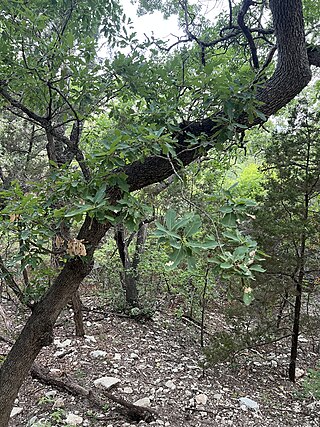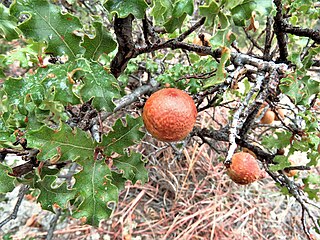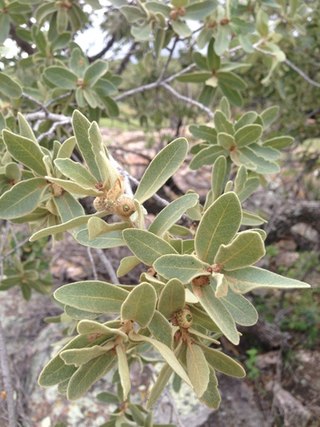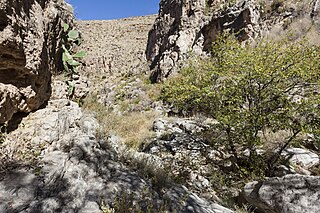
Quercus fusiformis, commonly known as escarpment live oak, plateau live oak, plateau oak, or Texas live oak, is an evergreen or nearly evergreen tree. Its native range includes the Quartz Mountains and Wichita Mountains in southwestern Oklahoma, through Texas, to the Mexican states of Coahuila, Tamaulipas, and Nuevo León.

Quercus tomentella, the island oak, island live oak, or Channel Island oak, is an oak in the section Protobalanus. It is native to six islands: five of the Channel Islands of California and Guadalupe Island, part of Baja California.

Quercus gambelii, with the common name Gambel oak, is a deciduous small tree or large shrub that is widespread in the foothills and lower mountains of western North America. It is also regionally called scrub oak, oak brush, and white oak.

Quercus laceyi, the Lacey oak, is a small to medium-size deciduous oak tree which is native to northeastern Mexico and to the Texas Hill Country in central Texas in the United States.

Quercus rugosa, commonly known as the netleaf oak, is a broad-leaved tree in the beech and oak family Fagaceae. It is native to southern North America.

Quercus chapmanii, commonly referred to as the Chapman oak, is a species of oak that grows in the southeastern United States.

Quercus polymorpha, the Mexican white oak, Monterrey oak or netleaf white oak, is a North American species of oak. It is widespread in Mexico, Guatemala, and Honduras, and known from a single population in the United States but widely planted as an ornamental.

Quercus turbinella is a North American species of oak known by the common names shrub oak, turbinella oak, shrub live oak, and gray oak. It is native to Arizona, California, New Mexico, Utah, Colorado, and Nevada in the western United States. It also occurs in northern Mexico.

Quercus pungens, commonly known as the sandpaper oak or scrub oak, is a North American species evergreen or sub-evergreen shrub or small tree in the white oak group. There is one recognised variety, Quercus pungens var. vaseyana, the Vasey shin oak. Sandpaper oak hybridizes with gray oak in the Guadalupe Mountains of New Mexico and Texas.

Quercus grisea, commonly known as the gray oak, shin oak or scrub oak, is a North American species deciduous or evergreen shrub or medium-sized tree in the white oak group. It is native to the mountains of the southwestern United States and northern Mexico. It hybridises with four other oak species where the ranges overlap, the Arizona white oak (Q. arizonica), the Gambel oak (Q. gambelii), the Mohr oak (Q. mohriana) and the sandpaper oak (Q. pungens).

Quercus chihuahuensis, the Chihuahua oak, is a species of oak in the beech family. It is native to the region from extreme western Texas west to Sonora, Mexico, and south to Zacatecas and San Luis Potosí. It grows mostly at mid elevations, from 400–2,000 metres above sea level, in forests mixed with various pines and other oaks. It is one of the dominant species of the Sierra Madre Occidental in Chihuahua and Sonora.
Iresine heterophylla, or Standley's bloodleaf, is a plant species native to the southwestern United States and also to Mexico. It has been collected from Arizona, New Mexico, Texas, Chihuahua, Sonora, Durango, Coahuila, Nuevo León, Campeche and Tabasco.
Quercus carmenensis, the Mexican oak, is a tree species native to Brewster County, Texas, and Coahuila, Mexico. It grows in pine-oak forests at elevations of 1,500–1,950 metres. It is a deciduous species with gray bark and red twigs. The leaves are lanceolate with irregular lobing along the margins.

Galium proliferum, also known as limestone bedstraw, is a species of plant in the Rubiaceae family. It is native to Northeastern Mexico and the Southeastern United States. More specifically, it can be found in American states California, southern Nevada, southern Utah, Arizona, New Mexico, Texas, as well as the Mexican states Coahuila and Nuevo León.

Cirsium texanum is a species of plants in the tribe Cardueae within the family Asteraceae found in North America. Common names include Texas thistle, Texas purple thistle or southern thistle. The species is native to northern Mexico and the southern Great Plains of the south-central United States.
Heterotheca fulcrata, known by the common name rockyscree false goldenaster, is a North American species of flowering plant in the family Asteraceae. It has been found in northern Mexico and in the western United States.

Quercus sinuata is a species of oak comprising two distinct varieties, Quercus sinuata var. breviloba and Quercus sinuata var. sinuata, occurring in southeast North America.

Quercus vaseyana is a species of tree in the beech family. It grows in northern Mexico and in the US state of Texas.

Quercus crassifolia is a species of oak. It is widespread in Mexico from Sonora and Chihuahua to Veracruz and Chiapas. It has also been found in Guatemala.

Quercus laeta is an oak species in the white oak section, Quercus section Quercus, in the beech family. It is widespread across much of Mexico from Sinaloa and Nuevo León south as far as Oaxaca.


















